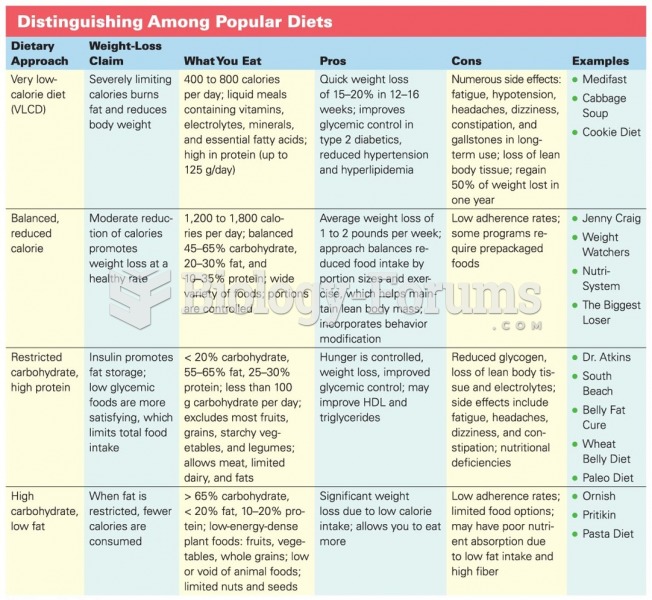Answer to Question 1
The energy needs of adolescents vary greatly, depending on the current rate of growth, gender, body composition, and physical activity. Boys' energy needs may be especially high; they typically grow faster than girls and, as mentioned, develop a greater proportion of lean body mass. An exceptionally active boy of 15 may need 3500 kcalories, or more, a day just to maintain his weight. Girls start growing earlier than boys and attain shorter heights and lower weights, so their energy needs peak sooner and decline earlier than those of their male peers. An inactive girl of 15 whose growth is nearly at a standstill may need fewer than 1800 kcalories a day if she is to avoid excessive weight gain. Thus, teenage girls need to pay special attention to being physically active and selecting foods of high nutrient density so that they will meet their nutrient needs without exceeding their energy needs.
Vitamin D is essential for bone growth and development. Recent studies of vitamin D status in adolescents show that many are vitamin D deficient; blacks, females, and overweight adolescents are most at risk. Adolescents who do not receive enough vitamin D from fortified foods such as milk and cereals, or from sun exposure each day, may need a supplement.
The need for iron increases during adolescence for both females and males but for different reasons. Iron needs increase for females as they start to menstruate and for males as their lean body mass develops. In addition, iron needs increase when the adolescent growth spurt begins, whether that occurs before or after age 14 . Iron intakes often fail to keep pace with increasing needs, especially for females, who typically consume fewer iron-rich foods such as meat and fewer total kcalories than males. Not surprisingly, iron deficiency is most prevalent among adolescent girls. Iron-deficient children and teens score lower on standardized tests than those who are not iron deficient.
Adolescence is a crucial time for bone development, and the requirement for calcium reaches its peak during these years. Unfortunately, many adolescents, especially females, have calcium intakes below recommendations. Low calcium intakes during times of active growth, especially if paired with physical inactivity, can compromise the development of peak bone mass, which is considered the best protection against adolescent fractures and adult osteoporosis.
Answer to Question 2
More than 31 million children receive lunches through the National School Lunch Programmore than half of them free or at a reduced price. School lunches are designed to provide at least a third of the recommendation for energy, protein, vitamin A, vitamin C, iron, and calcium. They must also include specified numbers of servings from each food group. In an effort to help reduce disease risk, all government-funded meals served at schools must follow the Dietary Guidelines for Americans.
The USDA Food and Nutrition Service recently updated the meal patterns and nutrition standards for school meals. Changes to meals include greater availability of fruits, vegetables, whole grains, and fat-free and low-fat milk, decreased levels of sodium, saturated fat, and trans-fat, and guidelines for meeting nutrient needs within specified kcalorie ranges based on age/grade groups for school children. Parents often rely on school lunches to meet a significant part of their children's nutrient needs on school days. Indeed, students who regularly eat school lunches have higher intakes of many nutrients and fiber than students who do not. Children don't always like what they are served, however, and school lunch programs must strike a balance between what children want to eat and what will nourish them and guard their health.
Serving nutritious lunches is only half the battle; students need to eat them, too. Short lunch periods and long lines prevent some students from eating a school lunch and leave others with too little time to complete their meals. Nutrition efforts at schools are also undermined when students can buy what the USDA labels competitive foodsmeals from fast-food restaurants or la carte foods such as pizza or snack foods and carbonated beverages from snack bars, school stores, and vending machines. These foods and beverages compete with nutritious school lunches. When students have access to competitive foods, participation in the school lunch program decreases, nutrient intake from lunch declines, and more food is discarded.
Increasingly, school-based nutrition issues are being addressed by legislation. The USDA recently published practical, science-based nutrition standards for all foods sold in schools, including snack foods and beverages. The standards encourage healthier snack foods while limiting junk foods.







